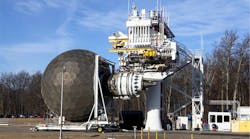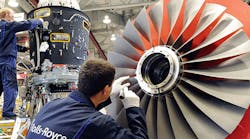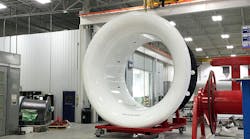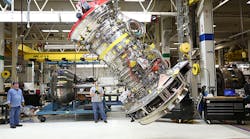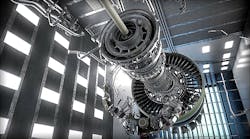Ceramic matrix composites are one of the breakthrough design elements for new, lighter aircraft engine designs, and also the subject of some uncertainty in the aerospace supply chain: how will these fairly novel materials perform in sustained service? Now, GE Aviation is reporting success in the second phase of component testing for its GEnx demonstrator engine, emphasizing the CMCs’ effective resistance to the damaging effects of environmental dust and debris.
CMCs consist of a ceramic material surrounding a matrix of silicon carbide ceramic fibers, sealed with a proprietary coating. According to GE Aviation, its CMCs have one-third the density of metal alloys, which contribute significantly to lower engine weight, thereby improving fuel efficiency and engine durability.
CMCs also are more heat resistant than metal alloys, which enhances engine performance by reducing the need for cooling air in the hot section. The GEnx design uses the cooling air in the engine flow path, so the engine is able to run more efficiently at higher temperature.
The GE9X, under development for the forthcoming Boeing 777X wide-body aircraft, is a 100,000-lb thrust commercial aircraft engine design with a 134-in. diameter composite fan case and 16 carbon-fiber composite fan blades. It will have 27:1 pressure-ratio 11-stage high-pressure compressor; a third-generation TAPS III combustor, for high efficiency and low emissions; and CMC material in the combustor and turbine.
GE Aviation has recorded orders for almost 700 of the new GE9X engines.
According to Ted Ingling, GE9X general manager for GE Aviation: "Dust and debris accumulate on the external surface of the airfoils and can degrade the insulation coatings. They can also collect on internal cooling circuits of the blades and nozzles and degrade the cooling effectiveness. Both factors can lead to durability issues.
“These demonstrator tests allow us to get an accelerated understanding of how our new designs and materials perform in all environments,” he continued, “including those prone to high airborne debris."
In its second testing round for the GEnx demonstrator engine, GE Aviation used the same CMC combustor liners, HPT stage 1 shrouds, and HPT stage 2 nozzles from the first round of tests in September 2015, along with the HPT stage 1 CMC nozzles.
"The majority of the CMC components experienced a total of nearly 4,600 cycles in the two testing phases in the GEnx demonstrator engine," according to Ingling. "All of the CMC components performed extremely well and continue to prove their value."
The GEnx CMC demonstrator engine also incorporates non-CMC parts, including titanium aluminide (TiAl), lightweight low-pressure turbine blades produced by additive manufacturing, and the HPT stage 1 blades with a proprietary system of cooling circuits that significantly enhance fuel efficiency.
Certification testing on the GE9X program will begin on GE Aviation's flying test bed in the first half of this year along. Engine certification is expected in 2018.
